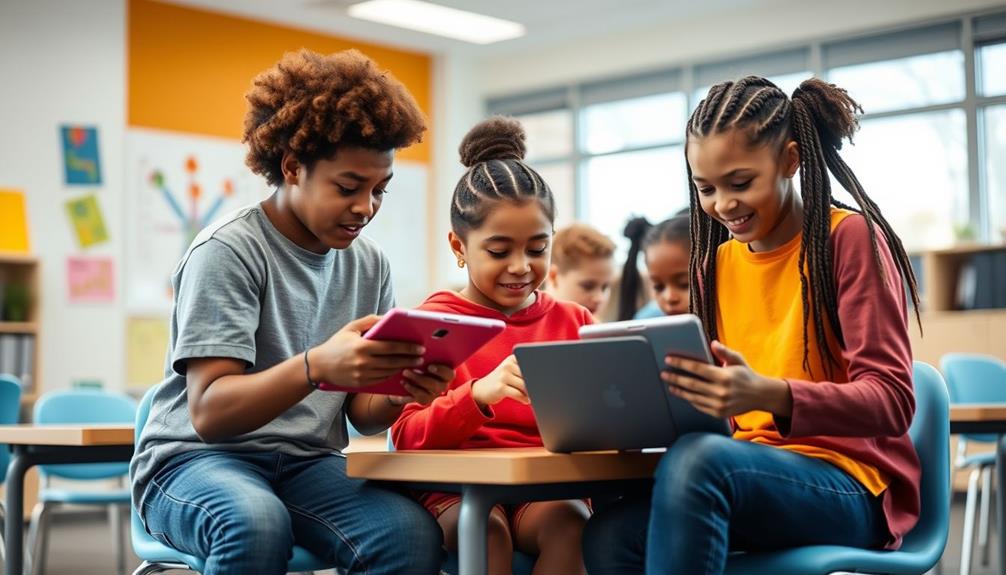AI-powered accessibility tools are revolutionizing education by fostering inclusivity for students with disabilities. With these tools, you can personalize learning experiences, ensuring that each student's unique needs are met. Technologies like real-time transcription and text-to-speech software empower students with hearing and visual impairments to engage fully in the classroom. These innovations promote a sense of belonging, allowing every learner to reach their full potential. By using AI, educators can monitor progress and adapt lessons in real-time, creating a supportive environment. If you're interested in how these tools are reshaping education, there's much more to explore.
Key Takeaways
- AI-powered accessibility tools personalize learning experiences, catering to diverse needs of students with disabilities to enhance engagement and effectiveness.
- Real-time transcription and text-to-speech technologies support students with hearing and visual impairments, promoting full participation in educational settings.
- Adaptive learning platforms facilitate personalized pathways, allowing students to progress at their own pace and reduce anxiety.
- Continuous data analysis through AI enables educators to monitor student performance and provide immediate feedback for improved outcomes.
- Ethical considerations, including data privacy and algorithmic bias, are crucial for ensuring equitable treatment and access to educational resources.
Importance of Accessibility in Education
Accessibility in education isn't just a necessity; it's a right that impacts millions of students. With approximately 7.3 million students in the U.S. living with disabilities, educational institutions must prioritize accessibility to guarantee everyone can thrive.
When you embrace inclusive practices, you're not only addressing the diverse needs of students with disabilities but also enhancing educational outcomes for all learners. Implementing strategies such as auditory discrimination goals can considerably improve students' listening skills, further enriching their learning experiences.
AI plays a pivotal role in creating personalized learning experiences. By incorporating assistive technologies, you can tailor educational content to meet individual requirements, making lessons more engaging and effective. This approach helps combat the rising rates of depression and anxiety, particularly exacerbated by distance learning challenges.
As digital fatigue grows among students, fostering an inclusive environment becomes even more essential. Quality education means recognizing the unique challenges faced by students with disabilities and providing them with equal opportunities for success.
When effective accessibility initiatives are in place, they promote a sense of belonging that enriches the learning experience for everyone. By prioritizing accessibility, you empower all students to reach their full potential, creating a more equitable educational landscape.
AI Technologies Enhancing Learning

AI technologies are transforming how you experience learning by creating personalized educational journeys tailored to your unique needs.
With innovations in assistive technology, you can access resources that support your learning style and pace. This evolution not only addresses bias and fairness in educational tools but also aligns with the growing demand for AI ethicists shaping guidelines in technology.
These advancements not only enhance engagement but also empower you to achieve greater independence in your education.
Personalized Learning Experiences
Personalized learning experiences are transforming education by adapting to each student's unique needs and preferences. With AI-powered tools, you're able to engage with educational content that's tailored just for you. These technologies not only enhance engagement but also address ethical considerations such as public awareness and education regarding the use of data in AI applications.
Adaptive learning platforms analyze your performance in real-time, adjusting lesson plans to guarantee you progress at your own pace. This means you won't be left behind or overwhelmed, making learning more enjoyable and effective.
For students with disabilities, these technologies can be a game-changer. Intelligent tutoring systems provide immediate feedback and targeted interventions, helping you improve your learning outcomes. Additionally, tools like speech recognition and text-to-speech software enhance accessibility, allowing you to participate more fully in educational settings, regardless of physical limitations.
Real-time analytics empower educators to monitor your progress closely. They can adjust their instructional strategies based on your unique learning patterns, fostering a supportive and personalized learning environment.
Assistive Technology Innovations
While traversing the challenges of modern education, you'll find that assistive technology innovations are making a significant impact on learning experiences for all students. AI-powered assistive technologies are revolutionizing accessibility, particularly for those with hearing impairments and visual disabilities.
| Technology | Benefit |
|---|---|
| Real-time Transcription Services | Provides immediate access to spoken content, enhancing classroom engagement. |
| Text-to-Speech Software | Enables visually impaired students to listen to educational materials, improving their participation. |
| Adaptive Interfaces | Automatically adjust to individual needs, creating a personalized learning experience for diverse learners. |
Innovations in AI-assisted technologies not only foster independence but also promote a sense of belonging among students with disabilities. For instance, tools like Google Live Transcribe help students with hearing impairments by converting spoken language into text in real time. Similarly, solutions like Speechify empower visually impaired learners by converting text into speech. These advancements guarantee that all students can navigate their educational journeys effectively, enriching their learning experiences and paving the way for a more inclusive classroom environment.
Overcoming Barriers With AI

Breaking down barriers in education has never been more achievable thanks to innovative AI-powered accessibility tools. These AI technologies are revolutionizing how you support students with disabilities, guaranteeing everyone can thrive in an inclusive education environment.
Real-time transcription services, for instance, empower students with hearing impairments by allowing them to fully engage in classroom discussions and can also be beneficial for students who may struggle with language, similar to how unique Akita names provide a personalized touch in pet ownership.
For visually impaired students, text-to-speech technologies turn written content into audible formats, enhancing their learning experience and independence. Meanwhile, speech recognition tools enable students with mobility impairments to communicate effectively, promoting active participation through voice commands.
AI-driven adaptive learning platforms play an essential role in overcoming barriers by analyzing student data to create personalized learning pathways tailored to individual needs. This approach not only fosters inclusivity but also guarantees that every student receives the support they require to excel.
Additionally, real-time language translation in multilingual classrooms helps break down language barriers, granting equitable access to learning for ESL students.
Personalized Learning Experiences

With AI, you can experience tailored learning pathways that cater specifically to your strengths and weaknesses. This technology allows for the incorporation of various learning styles, making education even more accessible for all students.
Real-time progress monitoring keeps you on track, allowing for adjustments that meet your needs. This personalized approach not only enhances your engagement but also boosts your confidence in learning.
For example, utilizing weight loss strategies can be adapted to support diverse learner needs.
Tailored Learning Pathways
AI-powered accessibility tools frequently revolutionize the way students engage with learning by creating tailored pathways that fit individual needs.
These AI tools analyze your unique learning style and preferences, allowing for personalized learning experiences that cater specifically to you. For students with disabilities, this means learning at your own pace, which can greatly reduce anxiety and enhance comprehension.
Additionally, these tools can incorporate insights from healthy lifestyle blogs, providing resources that promote overall well-being and support mental health.
With tailored learning pathways, educators can develop individualized education plans (IEPs) that target your specific challenges and strengths.
This data-driven approach guarantees that every lesson aligns with your needs, promoting inclusive education for all. AI tools dynamically adjust instructional content based on real-time assessment of your performance, ensuring that you're consistently engaged and supported throughout the learning process.
Real-Time Progress Monitoring
Real-time progress monitoring transforms personalized learning experiences by allowing educators to closely track your performance as you engage with the material.
With the help of AI systems, teachers can analyze data continuously, leading to:
- Tailored Learning Strategies: Adjustments can be made on the fly to suit your unique learning style, fostering an environment that encourages collaborative digital storytelling among peers.
- Personalized Feedback: Receive immediate insights that guide your learning, enhancing your understanding of concepts.
- Targeted Support for Students with Disabilities: Identifying areas where you may need extra help guarantees you're never left behind.
- Improved Educational Outcomes: Accurate, data-driven insights facilitate better support, paving the way for your academic success.
This proactive approach creates an engaging learning environment that fosters supportive learning journeys.
By utilizing real-time analytics, educators can alleviate academic pressure, allowing you to learn at your own pace while receiving timely assistance.
As a result, real-time progress monitoring not only enhances your learning experience but also empowers you to achieve your goals effectively.
Whether you're mastering new skills or overcoming challenges, this innovative approach guarantees you're equipped for success every step of the way.
Supporting Students With Disabilities

Many students with disabilities face unique challenges in traditional classroom settings, but innovative accessibility tools are changing the game. AI-powered accessibility tools are designed to enhance learning and provide essential support.
For instance, real-time transcription technology helps students with hearing impairments actively participate in discussions, ensuring they don't miss out on vital information. Furthermore, incorporating holistic lifestyle approaches can further support students' overall well-being, which is significant for their academic success.
Text-to-speech applications, like Speechify, empower visually impaired students by converting written materials into audible formats, allowing them to engage with learning resources independently. Additionally, students with learning disabilities, such as dyslexia, can benefit from customizable interfaces that cater to their specific needs, alongside predictive text suggestions that improve their reading and writing experiences.
AI-driven personalized learning platforms analyze individual data to tailor educational content, ensuring students with disabilities receive the necessary support to thrive academically.
In addition, real-time translation services break down language barriers, making it easier for non-native English speakers and ESL learners to participate in diverse classroom environments. By leveraging these tools, you can create a more inclusive educational experience that fosters success for all students with disabilities.
Ethical Considerations in AI

When you think about AI in education, you can't ignore the ethical considerations at play. Data privacy concerns, algorithmic bias, and the need for transparency in decision-making are critical for ensuring that these tools serve all students fairly.
For instance, understanding the implications of email and communication security is essential as educational institutions increasingly rely on digital communication.
Data Privacy Concerns
Data privacy concerns in AI are more pressing than ever, especially with the extensive collection of sensitive student information. You need to recognize that implementing robust measures is vital to safeguarding this data.
Here are four key areas to focus on:
- Confidentiality: Guarantee all student information remains private and protected from unauthorized access.
- Ethical Considerations: Establish guidelines that promote fair and transparent AI usage, tackling potential biases that could impact student outcomes.
- Diverse Stakeholders: Involve various parties in the AI development process to foster transparent decision-making and address different perspectives on data handling.
- Monitoring and Evaluation: Continuously assess AI systems to maintain data integrity and prevent misuse of sensitive information.
Educational institutions must prioritize data privacy by adhering to regulations and best practices.
When you prioritize these aspects during AI implementation, you enhance the overall effectiveness of accessibility tools while protecting your students.
Algorithmic Bias Mitigation
Mitigating algorithmic bias is essential for ensuring that AI-powered educational tools treat all students equitably, especially those with disabilities. When AI systems are trained on diverse data sets, they're more likely to reflect the needs of all learners, reducing the risk of biased outcomes.
To further enhance the effectiveness of these tools, it's important to incorporate strategies from protecting savings that emphasize thorough research and stakeholder input. Continuous monitoring of AI algorithms is imperative; it helps identify and address biases that may negatively impact marginalized student groups, ensuring that learning remains fair and effective.
Stakeholder involvement is key in this process. By including voices from various backgrounds, developers can promote ethical AI practices that consider the unique challenges faced by different communities.
Implementing bias audits can further enhance transparency in AI, fostering trust among users.
Moreover, government and nonprofit initiatives can play a significant role in enhancing AI literacy, which empowers educators and students to recognize and mitigate algorithmic bias. By promoting equitable access to AI tools, these initiatives help counteract the negative effects of bias, particularly in underserved communities.
Ultimately, addressing algorithmic bias isn't just about technology; it's about creating an inclusive educational environment where every student has the opportunity to succeed.
Transparency in Decision-Making
Transparency in AI decision-making is essential for fostering fairness and equity in educational outcomes. When you prioritize transparency in AI processes, you help guarantee that all students, especially those with disabilities, receive equitable support.
Here are four key benefits of transparency:
- Informed Stakeholders: Educators, parents, and students understand how AI tools work and how decisions are made.
- Trust Building: Clear ethical guidelines protect sensitive student data, fostering trust among all parties.
- Bias Identification: Continuous monitoring and evaluation of AI systems can reveal biased algorithms, allowing for timely corrections.
- Enhanced Inclusivity: Engaging diverse stakeholders in the development process mitigates potential biases, creating inclusive and equitable learning environments.
Data Privacy Concerns

In today's digital age, the integration of AI-powered accessibility tools in education brings about serious concerns regarding student privacy. These tools often require the collection of sensitive information, raising significant data privacy concerns.
You need to guarantee robust data protection measures are in place to safeguard personal information from unauthorized access, which could lead to breaches of student confidentiality. Compliance with regulations like the Family Educational Rights and Privacy Act (FERPA) is vital when implementing AI technologies in educational settings.
Without adherence to these regulations, students' sensitive data could be at risk. Additionally, potential biases in AI algorithms can inadvertently result in unequal treatment of students with disabilities. As a result, transparency in how data is handled and how decisions are made using AI must be prioritized.
Continuous monitoring and evaluation of these AI tools will help uphold ethical standards and guarantee that privacy remains a top priority throughout the educational experience. By addressing these data privacy concerns, you can create a safer, more inclusive environment for all students while leveraging the benefits of AI-powered accessibility tools.
Collaboration for Inclusive Education

Addressing data privacy concerns sets the stage for meaningful collaboration among educators, policymakers, and AI developers.
When these groups join forces, they can create AI tools that effectively cater to diverse student needs in inclusive education.
Here's how this collaboration can unfold:
- Engagement of stakeholders guarantees that AI tools are developed with input from all parties, minimizing biases and promoting equitable learning experiences.
- Training programs for educators enhance their ability to implement AI tools effectively, directly benefiting students with varying abilities.
- Community involvement fosters a supportive environment, where accessibility is prioritized, and every student feels valued.
- Regular feedback loops from users, including students and educators, are essential for the continuous improvement of AI applications, ensuring they remain effective and relevant.
Future Trends in Educational AI

Looking ahead, the domain of educational AI is poised for transformative growth, driven by innovations that personalize learning like never before. You'll witness the expansion of adaptive learning technologies that cater to each student's unique needs, promoting personalized learning experiences. AI-driven tutoring systems will provide on-demand support, helping you grasp complex subjects more effectively.
Innovations in immersive learning environments, supported by virtual and augmented reality, will create engaging educational experiences tailored to diverse learning styles. This integration will enhance accessibility and guarantee quality education reaches students in various contexts.
As we embrace these trends, the continuous advancement of AI analytics will offer real-time insights into student progress, enabling timely interventions that positively impact educational outcomes. The shift toward remote learning and hybrid models will further reshape the educational landscape, guaranteeing that learning remains inclusive and accessible.
| Trend | Impact on Education | Key Benefit |
|---|---|---|
| Adaptive Learning Technologies | Tailors content to individual needs | Personalized learning |
| AI-Driven Tutoring Systems | On-demand support for students | Enhanced understanding |
| Immersive Learning Environments | Engaging experiences in education | Diverse learning approaches |
Case Studies of AI Impact

As educational AI continues to evolve, its real-world applications demonstrate significant impacts on learning outcomes.
You'll find that AI-powered accessibility tools are transforming the classroom experience for students with disabilities. Here are some compelling case studies:
- Improved Classroom Participation: Implementing AI-powered speech recognition tools, like Google Live Transcribe, boosted participation among students with hearing impairments by 40%.
- Enhanced Reading Comprehension: Text-to-speech software, such as Speechify, increased reading comprehension by 30% for visually impaired students in a pilot program.
- Greater Engagement in Multilingual Settings: AI-based real-time translation services enhanced understanding among ESL learners by 50% in a diverse urban school district.
- Effective Personalized Learning: The use of adaptive learning platforms in special education settings led to a 25% increase in personalized learning outcomes, allowing students to progress at their own pace.
These studies illustrate how AI tools not only foster inclusive education but also improve educational outcomes, ensuring that every student can thrive in their learning environment.
Frequently Asked Questions
How Does AI Make Education More Accessible?
AI makes education more accessible by tailoring learning experiences to individual needs, providing real-time transcription, and facilitating communication. You'll find it easier to engage with content, participate in discussions, and connect with peers through these innovations.
How Can AI Be Used to Improve Education?
You can use AI to personalize learning experiences, analyze student performance, and provide real-time feedback. It helps you identify areas for improvement, adapt teaching methods, and enhance overall engagement in the educational process.
How AI Is Assistive Technology in Education?
Think of AI as a lighthouse, guiding students through the fog of learning. It's assistive technology that tailors educational experiences, helping you overcome barriers, enhancing engagement, and ensuring everyone has a fair chance to succeed.
How Does AI Affect Equity and Inclusion in Education?
AI enhances equity and inclusion in education by personalizing learning experiences, identifying individual needs, and automating tasks. It guarantees you have access to tailored support, fostering an environment where every student can thrive academically.
Conclusion
To sum up, AI-powered accessibility tools are transforming education, ensuring that every student has the opportunity to thrive. By breaking down barriers and personalizing learning experiences, we're creating a more inclusive environment for all. As we embrace these innovations, we must ask ourselves: how can we further harness technology to support those who need it most? The future of education is bright, but it's up to us to keep pushing for inclusivity and accessibility for everyone.











